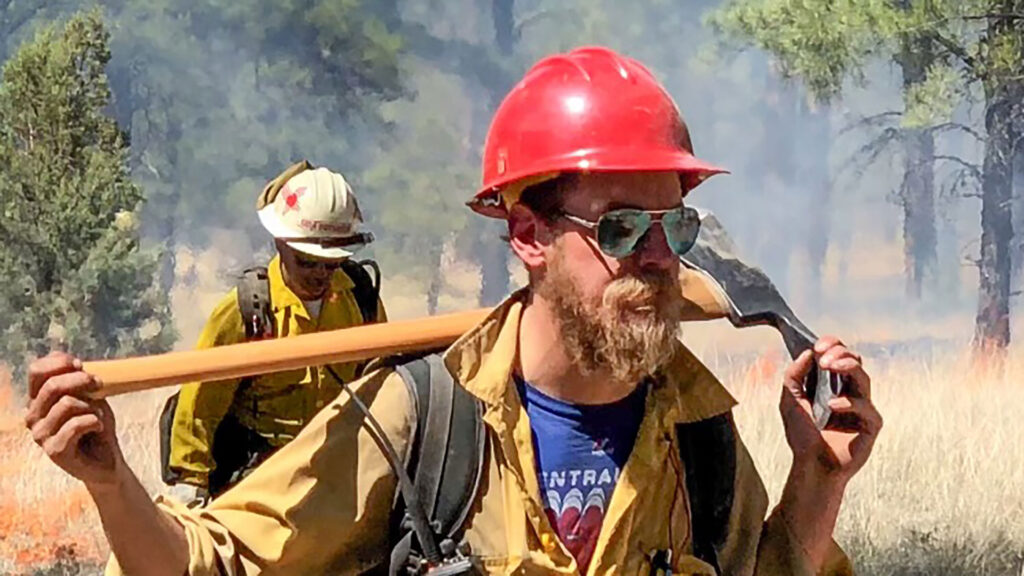‘We don’t jump the Bootheel’

On May 24, 2021, a campfire blew up along the U.S.-Mexico border in Hidalgo County. It was burning on the Diamond A Ranch, private land in the rugged Animas Mountains.
For more than two decades, people let fires burn there. But in 2021, the strategy was for full suppression. More than two seasons had passed without monsoon rains. It was hot. And it was windy.
With the closest engine seven hours away, smokejumpers were ordered to the fire — even though one captain warned: “We don’t jump the Bootheel; it is a pile of rocks and there are weird winds coming off of the Animas Mountains. We had a bad experience last time we jumped this.”
New Mexico’s Bootheel doesn’t have many roads. Security is an issue. And communication is spotty — for cell phones and emergency radios. And even en route to the fire, crews couldn’t use their satellite phones because they didn’t have the new SIM cards required.
One of the eight smokejumpers sent to the fire was Tim Hart, a six-year veteran of the West Yellowstone Jump Base.
As hot winds radiated off the sunbaked desert floor, Tim was the sixth jumper out of the plane.
About two hundred feet above the ground, his canopy sped up, and according to one of the other jumpers, he “came out of the air super fast, like he got caught in a burble.”
Tim landed on the side of a drainage in “rocks the size of garbage pails,” according to the accident report. He was unconscious when his fellow jumpers ran to him, and it was more than two hours until he arrived by air ambulance at the hospital in El Paso, where he died from his injuries nine days later.
Now, approaching the third anniversary of Tim’s death, I spoke with his wife, Michelle Hart. We talked about Tim. And about the challenges wildland firefighters and their families face.
Some of the news you might want to read:
• “Like It Or Not, a Hydrogen Ecosystem Is Coming to New Mexico” (Jerry Redfern, Capital & Main)
• “Disclosure rules unclear for commissioners set to decide on O&G wastewater rules” (Danille Prokop, Source NM)
• “Provision for acequia insurance hanging in balance as U.S. House and Senate debate Farm Bill” (Patrick Lohmann, Source NM)
• “Farmers and ranchers should take wildfire preparedness steps, state says” (Patrick Lohmann, Source NM)
• “How 3M Discovered, Then Concealed, the Dangers of Forever Chemicals” (Sharon Lerner, The New Yorker)
• “New Mexico to receive $18.9M in federal money for ‘forever chemical’ detection” (Danielle Prokop, Source NM)
• “Lawyers to Plastics Makers: Prepare for ‘Astronomical’ PFAS Lawsuits” (Hiroko Tabuchi, The New York Times)
• “The West’s wetlands are struggling. Some have been overlooked altogether.” (Natalia Mesa, High Country News)
• “My journey documenting New Mexico’s abandoned well issues” (Megan Gleason, Albuquerque Journal)
• “’Nothing Left For Me’ focuses on the trauma brought by the Navajo Livestock Reduction Program” (Megan Kamerick, KUNM)
• “Home insurance was once a ‘must.’ Now more homeowners are going without.” (Patrick Cooley, The Washington Post)
Newsletter readers will remember that last May, the Nuclear Regulatory Commission announced a special inspection of the URENCO USA uranium enrichment facility in Eunice.
The investigation came after a construction crane without the required safety controls was operating near a building that handles uranium hexafluoride. According to the NRC, that situation involved a “breakdown of controls designed to prevent chemical, radiological, and criticality hazards — the primary concern at U.S. fuel cycle facilities.”
According to the NRC, Louisiana Energy Services had committed other violations, too, prompting the federal body to levy a $70,000 civil penalty against the company.
Now, staff with the Nuclear Regulatory Commission are holding a hybrid public meeting to talk about their safety assessment of the uranium enrichment facility in Eunice.
On May 29, you can attend in person (Lea County Event Center, 5101 North Lovington Highway in Hobbs) or virtually via Microsoft Teams, or by phone at 301-576-2978, passcode 880639709#. You can also read the assessment online.
Lastly, if you missed the show last week, please check it out online. We spent the hour talking about lands and waters, and what the world could be like if we treated our rivers and landscapes — and one another — with a sense of respect and reciprocity.
P.S. If a friend forwarded you this message, sign up here to receive the newsletter yourself. You can also read recent newsletters online. And if you miss us throughout the week, follow Our Land on Instagram.


